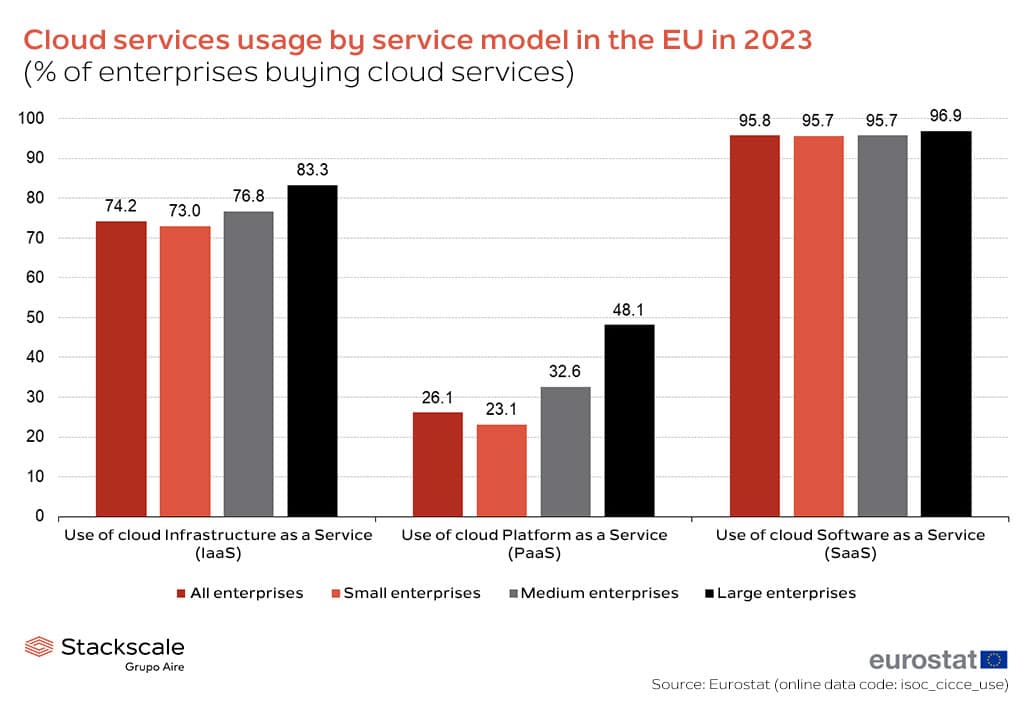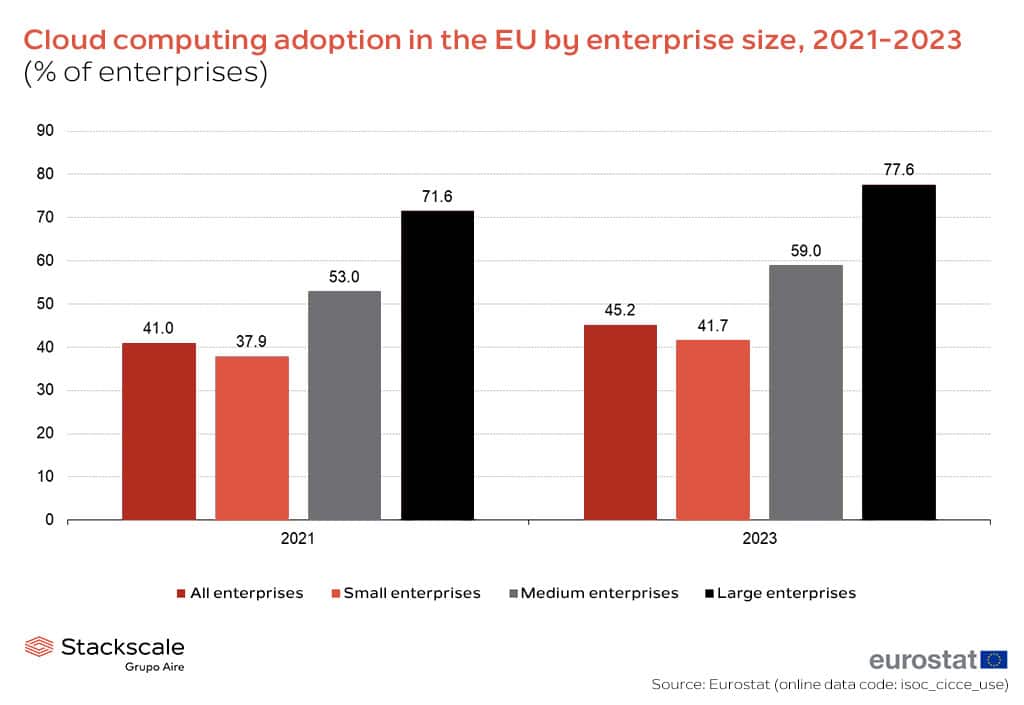The adoption of cloud computing in Europe has increased about 4 percentage points (pp) from 2021 to 2023, according to Eurostat. 45% of EU enterprises used cloud computing in 2023 — with a significantly higher adoption rate among large enterprises. Let’s review some cloud usage statistics among EU enterprises during the last few years.
Cloud adoption statistics in the EU by country from 2018 to 2023
Cloud adoption rates vary considerably among countries. As of 2023, on the one hand, Finland (78%), Sweden (72%), Norway (71%) and Denmark (70%) lead the adoption of cloud computing among enterprises in the European Union. On the other hand, Bulgaria (18%), Romania (18%) and Greece (24%) are the countries with the lowest cloud adoption rate.
The following table summarizes the evolution of cloud adoption among European enterprises from 2018 to 2023, according to Eurostat’s data.
| Country | 2018 | 2020 | 2021 | 2023 |
| EU average | 24% | 36% | 41% | 45% |
| Austria | 23% | 38% | 40% | 47% |
| Belgium | 40% | 53% | 53% | 52% |
| Bulgaria | 8% | 11% | 13% | 18% |
| Croatia | 31% | 39% | 39% | 45% |
| Cyprus | 27% | 35% | 50% | 53% |
| Czechia | 26% | 29% | 44% | 47% |
| Denmark | 56% | 67% | 65% | 70% |
| Estonia | 34% | 56% | 58% | 59% |
| Finland | 65% | 75% | 75% | 78% |
| France | 19% | 27% | 29% | 27%* |
| Germany | 22% | 33% | 42% | 47% |
| Greece | 13% | 17% | 22% | 24% |
| Hungary | 18% | 25% | 26% | 45% |
| Iceland | not available | not available | not available | not available |
| Ireland | 45% | 51% | 59% | 63% |
| Italy | 23% | 59% | 60% | 61% |
| Latvia | 15% | 21% | 29% | 36% |
| Lithuania | 23% | 31% | 34% | 38% |
| Luxembourg | 25% | 29% | 33% | 37% |
| Malta | 37% | 53% | 57% | 67% |
| Netherlands | 48% | 53% | 65% | 61% |
| Norway | 51% | 64% | 64% | 71% |
| Poland | 11% | 24% | 29% | 56% |
| Portugal | 25% | 29% | 35% | 38% |
| Romania | 10% | 16% | 14% | 18% |
| Slovakia | 21% | 26% | 36% | 34% |
| Slovenia | 26% | 39% | 43% | 40% |
| Spain | 22% | 26% | 31% | 30% |
| Sweden | 57% | 70% | 75% | 72%* |
*Break in time series
Cloud adoption in Austria
Cloud computing adoption among enterprises in Austria has almost doubled over the past six years, from 23% in 2018 to 45% in 2023.
Cloud adoption in Belgium
Cloud computing adoption among enterprises in Belgium has increased 12 pp over the past six years, from 40% in 2018 to 52% in 2023. The percentage of cloud adoption among Belgian enterprises has slightly decreased in 2023, compared to 2021.
Cloud adoption in Bulgaria
Cloud computing adoption among enterprises in Bulgaria has more than doubled over the past six years, from 8% in 2018 to 18% in 2023. However, Bulgaria, along with Romania and Greece, still holds an adoption rate below 25%.
Cloud adoption in Croatia
Cloud computing adoption among enterprises in Croatia has increased 14 pp over the past six years, from 31% in 2018 to 45% in 2023.
Cloud adoption in Cyprus
Cloud computing adoption among enterprises in Cyprus has almost doubled over the past six years, from 27% in 2018 to 53% in 2023. It is one of the countries that has experienced a bigger growth in cloud adoption during this period of time, together with Italy (+38 pp) and Malta (+30 pp).
Cloud adoption in Czechia
Cloud computing adoption among enterprises in Czechia has almost doubled over the past six years, from 26% in 2018 to 47% in 2023.
Cloud adoption in Denmark
Cloud computing adoption among enterprises in Denmark has grown 14 pp over the past six years, from 56% in 2018 to 70% in 2023. Together with Finland (78%), Sweden (72%) and Norway (71 %), Denmark is among the countries leading cloud computing adoption in the EU.
Cloud adoption in Estonia
Cloud computing adoption among enterprises in Estonia has increased 25 pp over the past six years, from 34% in 2018 to 59% in 2023.
Cloud adoption in Finland
Cloud computing adoption among enterprises in Finland has increased 13 pp over the past six years, from 65% in 2018 to 78% in 2023. Together with Sweden (72%), Norway (71%) and Denmark (70%), Finland is among the countries leading cloud computing adoption in the EU.
Cloud adoption in France
Cloud computing adoption among enterprises in France has grown 8 pp over the past six years, from 19% in 2018 to about 27% in 2023. The percentage of cloud adoption among French enterprises has slightly decreased in 2023, compared to 2021. Although, considering there are data breaks in time, this decrease is not fully accurate.
Cloud adoption in Germany
Cloud computing adoption among enterprises in Germany has more than doubled over the past six years, from 22% in 2018 to 47% in 2023. However, as of 2023, the percentage of German enterprises using cloud computing is still far from the cloud adoption rate in other countries like Finland (78%) or Sweden (72%).
Cloud adoption in Greece
Cloud computing adoption among enterprises in Greece has increased 11 pp over the past six years, from 13% in 2018 to 24% in 2023. Nevertheless, Greece, as well as Bulgaria and Romania, still holds an adoption rate below 25%.
Cloud adoption in Hungary
Cloud computing adoption among enterprises in Hungary has more than doubled over the past six years, from 18% in 2018 to 45% in 2023. However, as of 2023, the percentage of Hungarian enterprises using cloud computing is still far from the cloud adoption rate in other countries like Finland (78%), Sweden (72%) and Norway (71%).
Cloud adoption in Ireland
Cloud computing adoption among enterprises in Ireland has increased 18 pp over the past six years, from 45% in 2018 to 63% in 2023.
Cloud adoption in Italy
Cloud computing adoption among enterprises in Italy has almost tripled over the past six years, from 23% in 2018 to 61% in 2023. It is one of the countries that has experienced a bigger growth in cloud adoption during this period of time, together with Malta (+30 pp) and Cyprus (+26 pp).
Cloud adoption in Latvia
Cloud computing adoption among enterprises in Latvia has more than doubled over the past six years, from 15% in 2018 to 36% in 2023. However, as of 2023, the percentage of Latvian enterprises using cloud computing is still far from the cloud adoption rate in other countries like Finland (78%), Sweden (72%) and Norway (71%).
Cloud adoption in Lithuania
Cloud computing adoption among enterprises in Lithuania has increased 15 pp over the past six years, from 23% in 2018 to 38% in 2023.
Cloud adoption in Luxembourg
Cloud computing adoption among enterprises in Luxembourg has increased 12 pp over the past six years, from 25% in 2018 to 37% in 2023.
Cloud adoption in Malta
Cloud computing adoption among enterprises in Malta has almost doubled over the past six years, from 37% in 2018 to 67% in 2023. It is one of the countries that has experienced a bigger growth in cloud adoption during this period of time, together with Italy (+38 pp) and Cyprus (+26 pp).
Cloud adoption in the Netherlands
Cloud computing adoption among enterprises in the Netherlands has increased 13 pp over the past six years, from 48% in 2018 to 61% in 2023. Compared to 2021, the percentage of cloud adoption among Dutch enterprises has slightly decreased in 2023.
Cloud adoption in Norway
Cloud computing adoption among enterprises in Norway has increased 20 pp over the past six years, from 51% in 2018 to 71% in 2023. Together with Finland (78%) Sweden (72%) and Denmark (70%), Norway is among the countries leading cloud computing adoption in the EU.
Cloud adoption in Poland
Cloud computing adoption among enterprises in Poland has increased fivefold over the past six years, from 11% in 2018 to 56% in 2023. However, as of 2023, the percentage of Polish enterprises using cloud computing is still far from the cloud adoption rate in other countries like Finland (78%), Sweden (72%) and Norway (71%).
Cloud adoption in Portugal
Cloud computing adoption among enterprises in Portugal has increased 13 pp over the past six years, from 25% in 2018 to 38% in 2023.
Cloud adoption in Romania
Cloud computing adoption among enterprises in Romania has almost doubled over the past six years, from 10% in 2018 to 18% in 2023. However, Romania, as well as Bulgaria and Greece, still holds an adoption rate below 25%.
Cloud adoption in Slovakia
Cloud computing adoption among enterprises in Slovakia has increased 13 pp over the past six years, from 21% in 2018 to 34% in 2023. Compared to 2021, the percentage of cloud adoption among Slovakian enterprises has slightly decreased in 2023.
Cloud adoption in Slovenia
Cloud computing adoption among enterprises in Slovenia has increased 14 pp over the past six years, from 26% in 2018 to 40% in 2023. Compared to 2021, the percentage of cloud adoption among Slovenian enterprises has slightly decreased in 2023.
Cloud adoption in Spain
Cloud computing adoption among enterprises in Spain has increased 8 pp over the past six years, from 22% in 2018 to 30% in 2023. The percentage of cloud adoption among Spanish enterprises has slightly decreased in 2023, compared to 2021.
Cloud adoption in Sweden
Cloud computing adoption among enterprises in Sweden has increased 15 pp over the past six years, from 57% in 2018 to 72% in 2023. Together with Finland (78%), Norway (71%) and Denmark (70%), Sweden is among the countries leading cloud computing adoption in the EU. However, compared to 2021, the percentage of cloud adoption among Swedish enterprises has slightly decreased in 2023.
Cloud adoption in the EU by service model

Regarding usage rates by cloud service model, the Software as a Service model is definitely the most widely used among enterprises of all sizes, with an adoption rate above 95% in all cases. The Infrastructure as a Service model is the second most used, especially among large enterprises. The Platform as a Service model is the least used model, especially among small organizations.
Cloud computing adoption in the EU by enterprise size

Furthermore, cloud adoption rates also vary among enterprises of different sizes. As shown in the graph below, the adoption rate increases along with the company’s size.
As of 2023, the use of cloud computing continues to be higher among large enterprises, with an adoption rate of about 78%; followed by medium enterprises, with an adoption rate of 59% and small enterprises, with an adoption rate of about 42%. Besides, from 2021 to 2023, the increase in the use of cloud computing in large and medium companies is also slightly higher compared to small businesses, +6 pp and +4 pp respectively.
Cloud computing adoption and data sovereignty
When talking about cloud adoption in the EU, it is also worth mentioning that the cloud market is led by overseas companies — even though there are numerous European cloud providers that offer truly competitive cloud solutions.
This can have a negative impact on the medium and long term, in terms of data sovereignty, privacy, vendor lock-in issues, etc. That is why the European Commission has been working on developing a strong regulatory framework for data protection and sovereignty in Europe. Besides, projects like Gaia-X are also contributing to boost European cloud sovereignty by building a federated and secure data infrastructure.
Digital sovereignty is key. According to the report “European Digital Sovereignty. Syncing values and value” published by the consulting company Oliver Wyman, by 2030, the digital economy is expected to add 1,1 pp to the European Union’s annual economic growth and to boost GDP by over 14%. Therefore, it is important for European companies, as well as governments, to work together to promote innovation and digital sovereignty in the European Union.
Is your company planning to migrate its infrastructure to the cloud?
Stackscale can help you accelerate your cloud adoption with custom advice and up to 2-months free cloud migration.
Sources: Eurostat, Eurostat (isoc_cicce_use) and Oliver Wyman report.





